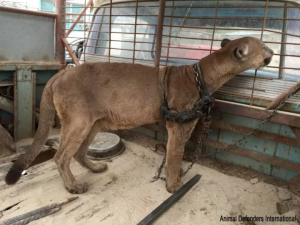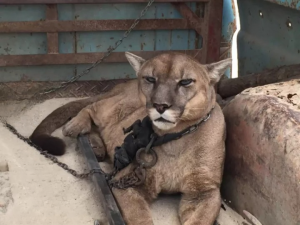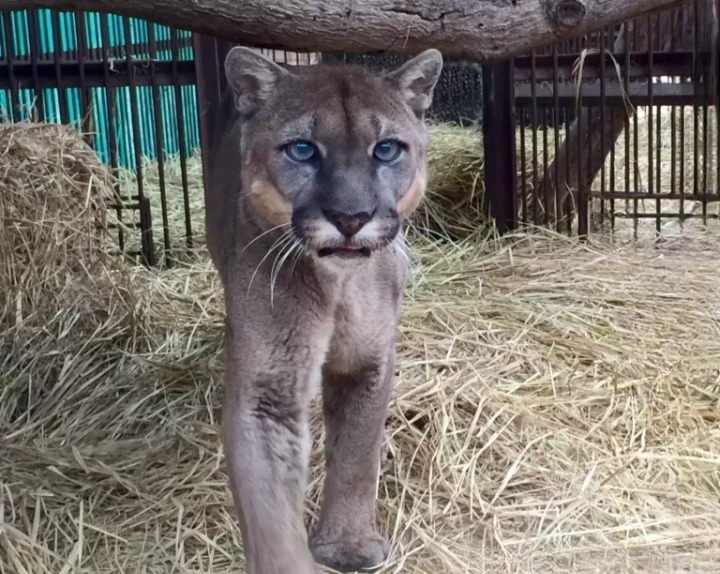In the bustling streets of Peru, life is often vibrant, colorful, and loud. But amidst the clamor of towns and villages, there was one soul whose life had been marked by silence, suffering, and restraint. For twenty long years, a majestic mountain lion named Mufasa lived not in the wild, but chained to the back of a moving truck, dragged from one circus performance to another. His story is one of cruelty, resilience, and, ultimately, hope.
A Life on the Move, Never at Home
Mufasa, perhaps named after the legendary character from The Lion King, never knew the freedom of the jungle, the open plains, or the quiet of his own territory. Instead, from infancy, he was forced into the life of a performer, likely sold illegally on the exotic pet trade, and destined for exploitation. Circuses in parts of the world often rely on exotic animals to draw crowds, but the cost of entertainment is steep, measured in suffering.

Unlike most circuses that at least house their animals in cages, Mufasa’s existence was far more horrific. He wasn’t confined in a cage or given any semblance of safety. He spent his days chained to a truck, with only a flimsy canopy of tent poles overhead for shelter. It’s hard to imagine a creature so powerful, so naturally dignified, living as if he were nothing more than circus equipment.
“It was heartbreaking to see Mufasa chained among the circus equipment, living on the back of a pickup truck,” said Jan Creamer, president of Animal Defenders International (ADI), the organization that eventually rescued him. “A heavy harness and chains were wrapped around his body, and as we cut them away, he stretched, free, for the first time.”

The Physical and Psychological Scars
When rescuers first laid eyes on Mufasa, the damage done to him was immediately apparent. Physically, he was severely underweight, his body showing signs of years of malnutrition. “It looked as though he hadn’t been fed properly, if at all, for some time,” the rescuers reported. But the real tragedy lay deeper.
The psychological toll of two decades of captivity was profound. Mufasa was understandably nervous and anxious, showing visible signs of fear whenever humans approached. His eyes, once expected to reflect the regal confidence of a lion, instead mirrored uncertainty and mistrust. For a creature born to roam vast territories, to climb, hunt, and explore, the world outside a moving truck was both terrifying and bewildering.
A Chance at Redemption: The Rescue
Hope arrived in the form of Animal Defenders International (ADI), a non-governmental organization dedicated to rescuing abused and exploited animals worldwide. When Mufasa was finally freed from his chains, it marked the beginning of a new chapter—one that would take immense patience, care, and rehabilitation.
He was transported to ADI’s Spirit of Freedom rescue center in Lima, Peru. This facility, specifically designed for the rehabilitation of rescued wildlife, provided the lion with the first real opportunity to live in conditions approximating his natural environment. For the first time in his life, Mufasa had space to move, room to breathe, and an environment focused on recovery rather than performance.
Rehabilitation: From Chains to Care
Recovery for animals like Mufasa is never straightforward. Years of abuse leave scars not only on the body but on the mind. ADI’s team of experts approached Mufasa’s rehabilitation meticulously, focusing on nutrition, physical conditioning, and psychological healing.
Specialist veterinary care was crucial. Over time, his appetite improved, and his coat, previously dull and patchy from stress and malnutrition, began to regain its former luster. “His appetite and coat condition have improved after receiving specialist veterinary treatment,” the group noted. But beyond the physical, rescuers also worked on his confidence and trust. Gentle interactions, gradual exposure to the sights and sounds of a more natural environment, and careful handling helped Mufasa understand that not all humans would cause him harm.
Even with this care, progress was slow. For a lion that had never walked freely, the first steps were monumental. And when they came, they weren’t just steps—they were a symbol of survival, resilience, and the incredible capacity for recovery when given the chance.
The Emotional Impact on Rescuers
For those who witnessed Mufasa’s first movements, the experience was deeply emotional. “Seeing him stretch and walk freely for the first time was overwhelming,” said Jan Creamer. “It’s a moment that stays with you—it reminds you why we do this work.”
Rescuers often describe moments like these as bittersweet. On one hand, there’s the joy of liberation; on the other, the knowledge of the suffering endured before that freedom. For Mufasa, two decades of captivity were replaced in mere weeks by a life in which he could finally express his natural behaviors: pacing, stretching, exploring, and even play.
Broader Implications: Illegal Wildlife Trade and Circus Abuse
Mufasa’s story is, unfortunately, not unique. Across South America, Africa, and Asia, countless exotic animals are subjected to similar treatment. The illegal wildlife trade thrives on demand for exotic pets and entertainment, often ignoring the laws of animal welfare and the basic needs of these creatures. Circuses, in particular, have long been criticized for exploiting animals, forcing them into unnatural behaviors for profit.
Groups like ADI are at the forefront of combatting this abuse, not only rescuing individual animals but also advocating for stronger laws, enforcement, and public awareness. Every rescue like Mufasa’s highlights the need for systemic change. Awareness campaigns, petitions, and legal action have gradually forced some countries to reconsider or ban the use of wild animals in entertainment altogether.
A Future of Freedom
Now, with his chains gone and his first steps taken, Mufasa’s future is filled with hope. At the Spirit of Freedom rescue center, he has access to the space, enrichment, and care that were long denied. Staff continue to monitor his health, offer psychological stimulation, and provide companionship with other rescued animals where possible.
The transformation is remarkable. From a scared, malnourished, chained lion, Mufasa is becoming a symbol of resilience. His story inspires not only those who work directly in animal welfare but also everyday people who may feel powerless against the scale of cruelty in the world.
Lessons Learned and Shared
Mufasa’s journey teaches several powerful lessons. First, the human capacity for cruelty is matched only by our capacity for compassion. One organization’s intervention changed the life of a creature who had known only pain for twenty years. Second, rehabilitation is a complex, patient process. True recovery requires attention to both physical and psychological needs, tailored to the individual animal. And finally, the fight against animal exploitation is ongoing. Each rescue is a victory, but systemic change is needed to prevent abuse before it begins.
Inspiring Global Action
Stories like Mufasa’s often inspire others to act. Donations, volunteer work, and advocacy can all play a role in supporting organizations like ADI. Additionally, they help to raise awareness about the realities of the exotic pet trade and circus exploitation. Many people, upon learning about Mufasa’s plight, express shock that such suffering could exist in the modern world. Yet, it also ignites hope that collective action can create tangible change.
Conclusion: A New Dawn
Mufasa’s first steps are more than just a milestone for one lion—they are a testament to endurance, care, and the possibility of redemption. The road ahead will continue to involve rehabilitation, enrichment, and monitoring, but the most critical step has been taken: freedom.
His story resonates as a call to action. It reminds the world that behind every chained animal is a life that deserves dignity, compassion, and respect. And for those who have the opportunity to help, it is a reminder that no act of kindness is ever too small to change the course of an animal’s life.
Mufasa now roams not just the grounds of a rescue center but also the imaginations and hearts of those who hear his story. Twenty years of captivity could not crush his spirit; twenty years of suffering could not erase the possibility of a brighter future. He is, at last, a lion who walks freely—a living testament to resilience, hope, and the enduring power of compassion.
